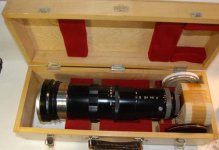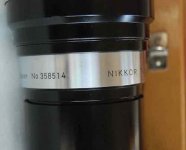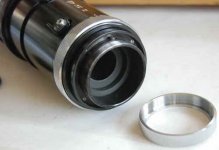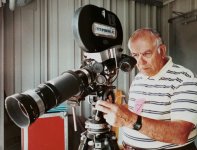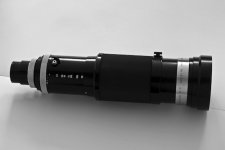wes loder
Photographer/Historian
I recently acquired an 8.5cm~25cm Zoom Nikkor with a 2 inch short mount. It came that way from the factory. Lens is not automatic but features a semi-auto diaphragm. I believe it may have been intended for television camera work. Anyone ever see a 51mm (2 inch) mount before? Thanks, WES
wes loder
Photographer/Historian
Different 85~250 Zoom
Different 85~250 Zoom
The wood case is NK original complete with NK logo on front. Not all Nikon wood cases have plastic grips. My PF copy stand and my P copy kit both have leather handles made the same way.
This is the same version of the 8.5cm~25cm Nikkor Zoom that Brasczko shows in his book, but not the same lens. Braszko is incorrect in stating that it was for the Nikon Reflex Housing. There is not enough room at the back of the lens to fit a Nikon housing in. I believe it is designed to go on a TV production studio camera, but I have never seen a two inch lens mount. It may be a short mount to take an adapter to fit various makes of cameras.
Also note that this is a "Nikkor Telephoto Zoom," NOT an "Auto Nikkor Telephoto Zoom." So, it never started life as a version for the Nikon F. Serial number is not part of the Type 1 series for the F either. WES
Different 85~250 Zoom
The wood case is NK original complete with NK logo on front. Not all Nikon wood cases have plastic grips. My PF copy stand and my P copy kit both have leather handles made the same way.
This is the same version of the 8.5cm~25cm Nikkor Zoom that Brasczko shows in his book, but not the same lens. Braszko is incorrect in stating that it was for the Nikon Reflex Housing. There is not enough room at the back of the lens to fit a Nikon housing in. I believe it is designed to go on a TV production studio camera, but I have never seen a two inch lens mount. It may be a short mount to take an adapter to fit various makes of cameras.
Also note that this is a "Nikkor Telephoto Zoom," NOT an "Auto Nikkor Telephoto Zoom." So, it never started life as a version for the Nikon F. Serial number is not part of the Type 1 series for the F either. WES
Attachments
NIKON KIU
Did you say Nippon Kogaku
Can we see a picture of the mount?
It's hard to ID without seeing. Is there a cap for it?
Kiu
It's hard to ID without seeing. Is there a cap for it?
Kiu
What is the serial number?
wes loder
Photographer/Historian
Rear mt and Serial No of Zoom
Rear mt and Serial No of Zoom
Kieu & Steve:
I am attaching two images that show the rear mount and serial number.
The mount, as I said, appears to be two inch thread with a pitch of 24 threads per inch. Note a projecting pin at 12 o'clock that might have be used to position an adapter prior to screwing it on. It has sorta' a cap (see lower right hand corner of picture), but it is open. Might serve to protect the threads, but not protect the interior of the lens. This picture should give you a better idea as to how the cocking and release mechanism for the diaphragm works.
Serial number is 358514. Same sequence as the Braszko lens, but considerably higher, indicating a run of more than 500 in the series. Note also the absence of the word "Auto" from the beauty ring. How this helps, WES
Rear mt and Serial No of Zoom
Kieu & Steve:
I am attaching two images that show the rear mount and serial number.
The mount, as I said, appears to be two inch thread with a pitch of 24 threads per inch. Note a projecting pin at 12 o'clock that might have be used to position an adapter prior to screwing it on. It has sorta' a cap (see lower right hand corner of picture), but it is open. Might serve to protect the threads, but not protect the interior of the lens. This picture should give you a better idea as to how the cocking and release mechanism for the diaphragm works.
Serial number is 358514. Same sequence as the Braszko lens, but considerably higher, indicating a run of more than 500 in the series. Note also the absence of the word "Auto" from the beauty ring. How this helps, WES
Attachments
sevo
Fokutorendaburando
It is a bit odd that the lens has a full set of barrel inscriptions instead of cogs for remote control - a TV (electronic) camera lens that old (from a era well before ENG) would almost invariably have been in a blimp box, and focused/zoomed from the camera control unit installed in the control room/car.
wes loder
Photographer/Historian
TV cameras
TV cameras
"a TV (electronic) camera lens that old (from a era well before ENG) would almost invariably have been in a blimp box, and focused/zoomed from the camera control unit installed in the control room/car."
Not necessarily. Plenty of TV studio cameras were mounted on tripod/dolly combos with individual operators standing behind each one controlling the zoom and focus. The camera may have been blimped, but not the lens. To see a 1960-vintage TV studio camera with the 85~250 zoom mounted on it go to: <http://www.johninmontana.com/montana/channel8.htm>. Picture is third one down on right.
IT appears that some kind of servo or manual remote controls were added to the lens but how this was done is not apparent from the picture. I wonder if the large screw underneath the zoom ring was intended for securing a remote focus? But maybe not since the F version also has that screw. WES
TV cameras
"a TV (electronic) camera lens that old (from a era well before ENG) would almost invariably have been in a blimp box, and focused/zoomed from the camera control unit installed in the control room/car."
Not necessarily. Plenty of TV studio cameras were mounted on tripod/dolly combos with individual operators standing behind each one controlling the zoom and focus. The camera may have been blimped, but not the lens. To see a 1960-vintage TV studio camera with the 85~250 zoom mounted on it go to: <http://www.johninmontana.com/montana/channel8.htm>. Picture is third one down on right.
IT appears that some kind of servo or manual remote controls were added to the lens but how this was done is not apparent from the picture. I wonder if the large screw underneath the zoom ring was intended for securing a remote focus? But maybe not since the F version also has that screw. WES
sevo
Fokutorendaburando
Well, so there are no reasons why it won't be a TV lens? They are known to have been sold for that purpose, and short mounts are common in that field. If it walks like a duck and quacks like a duck...
My guess is that you have a one off adapted lens to who knows what special purpose.
There were many professional photo machine shops in Los Angeles and NYC during the hey days of film Hollywood, adapting virtually anything to everything.
I could be wrong, but that does not look like a Nikon factory made mount to me.
One problem is that factories want production, not unusual mounts. Whether TV lens or big screen movie camera, no idea.
A 85-250 zoom would probably be more useful for location 35mm movie cameras or on site TV reporting than sound stages.
At one time this was the ONLY Japanese made tele zoom for 35mm photography, which could be the reason for an expensive one off adaptation.
As Braszko points out, the short mount zoom was announced and in the price list.
Accordingly we can be sure that short mount zoom existed and worked properly at least in prototype form,
even if your particular lens could not mount to a Nikon Reflex housing(with the proper mount).
There were many professional photo machine shops in Los Angeles and NYC during the hey days of film Hollywood, adapting virtually anything to everything.
I could be wrong, but that does not look like a Nikon factory made mount to me.
One problem is that factories want production, not unusual mounts. Whether TV lens or big screen movie camera, no idea.
A 85-250 zoom would probably be more useful for location 35mm movie cameras or on site TV reporting than sound stages.
At one time this was the ONLY Japanese made tele zoom for 35mm photography, which could be the reason for an expensive one off adaptation.
As Braszko points out, the short mount zoom was announced and in the price list.
Accordingly we can be sure that short mount zoom existed and worked properly at least in prototype form,
even if your particular lens could not mount to a Nikon Reflex housing(with the proper mount).
wes loder
Photographer/Historian
Steve:
I do not believe this is a "One-off." Sure looks like a factory-made mount to me. I believe that it was manufactured by Nippon Kogaku in this form and sold that way. I also believe it was sold for TV camera work, but admit I do not yet have proof of that.
1) The serial number is not in the range for the Type 1, F mount 8.5~25 zooms.
2) It has no tripod mounting—and never did have one. An adapted F mount Zoom would have holes where the tripod mount would have been.
3) It is not an "Auto" lens and is correctly so marked.
4) The semi-automatic lever is built-in—not changed later.
The absence of a tripod mounting is a clue that this is not, nor ever was, a lens for a reflex housing. No way that a reflex housing of any type would bear the weight of this lens. But it makes no sense to put a tripod mount on a TV lens since all the weight is in the camera.
You are correct that companies want production (although NK made some awfully small runs of many items). But Nikon sold fewer than a thousand reflex housings and by the fall of 1960 the market for RF housings sales was already dead. Why would the company even think there might be a market for such a configuration?
On the other hand, Leitz sold over 30,000 Visoflexes, so a small market might have been there.
The Braszko lens is the same model as this one, which means it never would have fit on a Nikon reflex housing either. There is not enough room between the diaphragm ring and focal plane to fit a Nikon reflex housing in. There is room for a Visoflex. In the case of the Braszko unit, I believe someone made an adapter to mount a Visoflex. But the lens was not designed for that purpose originally (see comment on lack of tripod mount above).
I have been in TV studios with two-camera setups, each camera sporting a 50~300 Nikkor zooms. The Montana camera I referenced earlier is on a studio camera, so they were used in studio production.
I have never seen a listing for the 8.5~25 Zoom in short mount. Does it say that it would be in the Nikon mount? Regardless, this lens and the one in the Braszko book are not the ones that such a listing would have referred to.
Glad to see so much interest in this topic. WES
I do not believe this is a "One-off." Sure looks like a factory-made mount to me. I believe that it was manufactured by Nippon Kogaku in this form and sold that way. I also believe it was sold for TV camera work, but admit I do not yet have proof of that.
1) The serial number is not in the range for the Type 1, F mount 8.5~25 zooms.
2) It has no tripod mounting—and never did have one. An adapted F mount Zoom would have holes where the tripod mount would have been.
3) It is not an "Auto" lens and is correctly so marked.
4) The semi-automatic lever is built-in—not changed later.
The absence of a tripod mounting is a clue that this is not, nor ever was, a lens for a reflex housing. No way that a reflex housing of any type would bear the weight of this lens. But it makes no sense to put a tripod mount on a TV lens since all the weight is in the camera.
You are correct that companies want production (although NK made some awfully small runs of many items). But Nikon sold fewer than a thousand reflex housings and by the fall of 1960 the market for RF housings sales was already dead. Why would the company even think there might be a market for such a configuration?
On the other hand, Leitz sold over 30,000 Visoflexes, so a small market might have been there.
The Braszko lens is the same model as this one, which means it never would have fit on a Nikon reflex housing either. There is not enough room between the diaphragm ring and focal plane to fit a Nikon reflex housing in. There is room for a Visoflex. In the case of the Braszko unit, I believe someone made an adapter to mount a Visoflex. But the lens was not designed for that purpose originally (see comment on lack of tripod mount above).
I have been in TV studios with two-camera setups, each camera sporting a 50~300 Nikkor zooms. The Montana camera I referenced earlier is on a studio camera, so they were used in studio production.
I have never seen a listing for the 8.5~25 Zoom in short mount. Does it say that it would be in the Nikon mount? Regardless, this lens and the one in the Braszko book are not the ones that such a listing would have referred to.
Glad to see so much interest in this topic. WES
View Range
Well-known
As I understand it, during that period the Leica M mount patent was still enforced. There were no third party M mount lenses then. I doubt Nikon would have violated the patent.
There were Leica M Visoflex adapters for the Kilfitt KI/AN/WE, Novoflex Follow Focus / Nesting lens, and Komura Uni lens systems and also for simple LTM to LBM adapters made by the same manufactures. I assume these were approved by Leica.
What is really puzzling is the unique serial number sequence and the span of serial numbers. If that many lenses were made, they could be frequently be seen.
There were Leica M Visoflex adapters for the Kilfitt KI/AN/WE, Novoflex Follow Focus / Nesting lens, and Komura Uni lens systems and also for simple LTM to LBM adapters made by the same manufactures. I assume these were approved by Leica.
What is really puzzling is the unique serial number sequence and the span of serial numbers. If that many lenses were made, they could be frequently be seen.
As I understand it, during that period the Leica M mount patent was still enforced. There were no third party M mount lenses then. I doubt Nikon would have violated the patent.
There were Leica M Visoflex adapters for the Kilfitt KI/AN/WE, Novoflex Follow Focus / Nesting lens, and Komura Uni lens systems and also for simple LTM to LBM adapters made by the same manufactures. I assume these were approved by Leica.
What is really puzzling is the unique serial number sequence and the span of serial numbers. If that many lenses were made, they could be frequently be seen.
Not the M mount, the 39mm mount with a M adapter to Visoflex
or the screw mount Viso II.
Stephen
sevo
Fokutorendaburando
If that many lenses were made, they could be frequently be seen.
Not necessarily if they went into TV. Back then, that still was a state operated affair in most of the world, where economic rules like selling off the surplus often did not apply - on the contrary, tax exemption rules sometimes make it impossible or at least unprofitable to transfer anything out of that public domain. At one of my former employers in the German TV system, a technician was fired for "theft" and fined for a tax fraud after he was caught dustbin diving after some Nagra tape decks they had disposed of as waste.
View Range
Well-known
Stephen, all Viso II, where for LTM or LBM cameras, had an M mount on the front. L39 mount with an adapter is possible, but I don't see it in the small photos we have. The picture shows an LBM Viso II or III.
In the US dumpster diving by employees is also illegal, but legal sale of surplus equipment is common.
In the US dumpster diving by employees is also illegal, but legal sale of surplus equipment is common.
wes loder
Photographer/Historian
I took some measurements off my lens. There is just space for a Visoflex I housing on the back of mounting. Of course a Visoflex II/III, which only requires 67.8mm of space, should fit with some space to spare. However, the Braczko/Lownds lens does not appear to use that much space. There is definitely not enough space for a Nikon Reflex housing which requires 108.8mm depth to the focal plane.
I would note that this lens and its case both had a embossed tape label of "K58." This would suggest an inventory mark of some kind—not the kind of label a private individual would use. The lens also came with its original "passed" inspection card from NK. Cool.
Fred: I would agree that lenses for TV cameras needed a cable or motor system to transfer focus and zoom settings. But many times those attached to the lens with collars clamped around the lens controls. It is a puzzle. WES
I would note that this lens and its case both had a embossed tape label of "K58." This would suggest an inventory mark of some kind—not the kind of label a private individual would use. The lens also came with its original "passed" inspection card from NK. Cool.
Fred: I would agree that lenses for TV cameras needed a cable or motor system to transfer focus and zoom settings. But many times those attached to the lens with collars clamped around the lens controls. It is a puzzle. WES
Dwig
Well-known
...
Fred: I would agree that lenses for TV cameras needed a cable or motor system to transfer focus and zoom settings. But many times those attached to the lens with collars clamped around the lens controls. It is a puzzle. WES
Actually, TV cameras of the period, such as the RCA TK-44 series and earlier B&W models, did not focus by adjusting the lens and used no such transfer cables for focus. They focused internally by moving the imaging tubes forward and backward. Zooming was new and novel and there were no conventions yet.
View Range
Well-known
Wes, as I recall Viso II/III is 40.0 + 28.8 (LTM) or 41.0 + 27.8 (LBM) for a total of 68.8mm. I recall PLOOT/Viso I is 62.5 + 28.8 (LTM) for 63.5 + 27.8 (LBM) for a total of 91.3mm. I don't see how there is that much room for Viso I, just looking at the small pictures.
wes loder
Photographer/Historian
Wes, as I recall Viso II/III is 40.0 + 28.8 (LTM) or 41.0 + 27.8 (LBM) for a total of 68.8mm. I recall PLOOT/Viso I is 62.5 + 28.8 (LTM) for 63.5 + 27.8 (LBM) for a total of 91.3mm. I don't see how there is that much room for Viso I, just looking at the small pictures.
Well, I did some careful measurements, and if I remove the two-inch short mount, I have just enough room to fit in an adapter for the Kilfittscope in Nikon/Contax mount (thread in front, bayonet in rear), and achieve infinity focus. It will be a tight fit. Will let everyone know if it works. If it does work, a Visoflex I should work as well, since it requires 2 millimeters less space.
Fred: Thanks for the pictures. Yours is similar to the TV Nikkor I found on-line on Montana. Both have the same black beauty rings. Different serial number series. But what is the lens mount? WES
Dwig
Well-known
3-tube Plumbicon color cameras were technically way too sophisticated for this lens. ...
Correct. My post was somewhat in error due to sloppy editing.
The camera I intended to refer to was the TK-41 and its various siblings. These were introduced in the early '50s and along with their siblings, dominated color TV in the US and several other countries for most of the next 10 years and overlap the era of the Nikkor 8.5-25cm.
The TK-44 was introduced well after the period of the lens in question. These, and their 44a and 44b siblings, were much more "modern" cameras.
wes loder
Photographer/Historian
Solution to the 85~250 mystery?
Solution to the 85~250 mystery?
Fred, I got an answer from the Montana TV engineer. Their 8.5cm~25cm Zoom is the same version as the one you pictured, and (serial #257965) in the same series. So my lens is not a TV camera lens—or at least not in the same way.
What it is a 35mm Movie camera lens.
The short mount will take a Arriflex adapter, or something similar. Uli Koch put me onto the solution. He has a Type 2 85~250 with the same semi-auto diaphragm and the same chrome ring at the back in Arriflex mount. Looks like the Arriflex adapter slips through the ring and then the ring locks it onto the lens. This explains the depth of the case, assuming the lens would be stored with the adapter on the lens. And it explains the opening in the ring.
Being designed for movie camera work, there would be no need to motorize the controls for rear-of-camera operation, although that still might be a possibility.
As I stated earlier, this lens was never designed for reflex housing mounting. Nor was the Braczko/Lownds lens. Someone did an adaption to a Visoflex III and it worked.
I am attaching a picture Uli sent me of his lens. It is a type 2 with the single focus and zoom control ring. Note the semi-automatic cock and release for the diaphragm and the chrome ring at the back that secures the Arriflex mount to the lens.
The other picture shows a Type 2 mounted on an Arriflex. In this case a remote control for the zoom (but not the focus) has been added, and a rod attached to the diaphragm ring with a hose clamp to allow easy diaphragm changes. I think this answers my question, but I am still doing research, and if I find anything new, I will share it. Thank you for all your suggestions. WES
Solution to the 85~250 mystery?
Fred, I got an answer from the Montana TV engineer. Their 8.5cm~25cm Zoom is the same version as the one you pictured, and (serial #257965) in the same series. So my lens is not a TV camera lens—or at least not in the same way.
What it is a 35mm Movie camera lens.
The short mount will take a Arriflex adapter, or something similar. Uli Koch put me onto the solution. He has a Type 2 85~250 with the same semi-auto diaphragm and the same chrome ring at the back in Arriflex mount. Looks like the Arriflex adapter slips through the ring and then the ring locks it onto the lens. This explains the depth of the case, assuming the lens would be stored with the adapter on the lens. And it explains the opening in the ring.
Being designed for movie camera work, there would be no need to motorize the controls for rear-of-camera operation, although that still might be a possibility.
As I stated earlier, this lens was never designed for reflex housing mounting. Nor was the Braczko/Lownds lens. Someone did an adaption to a Visoflex III and it worked.
I am attaching a picture Uli sent me of his lens. It is a type 2 with the single focus and zoom control ring. Note the semi-automatic cock and release for the diaphragm and the chrome ring at the back that secures the Arriflex mount to the lens.
The other picture shows a Type 2 mounted on an Arriflex. In this case a remote control for the zoom (but not the focus) has been added, and a rod attached to the diaphragm ring with a hose clamp to allow easy diaphragm changes. I think this answers my question, but I am still doing research, and if I find anything new, I will share it. Thank you for all your suggestions. WES
Attachments
Share:
-
This site uses cookies to help personalise content, tailor your experience and to keep you logged in if you register.
By continuing to use this site, you are consenting to our use of cookies.


